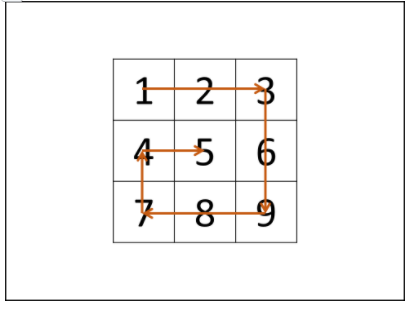顺时针打印矩阵
题目
输入:matrix = [[1,2,3],[4,5,6],[7,8,9]]
输出:[1,2,3,6,9,8,7,4,5]
解题思路
考虑设定矩阵的“左、上、右、下”四个边界,模拟以上矩阵遍历顺序

算法流程:
空值处理: 当 matrix 为空时,直接返回空列表 [] 即可。
1.初始化: 矩阵 左、右、上、下 四个边界 l , r , t , b ,用于打印的结果列表 res 。
2.循环打印: “从左向右、从上向下、从右向左、从下向上” 四个方向循环,每个方向打印中做以下三件事 (各方向的具体信息见下表) ;
3.根据边界打印,即将元素按顺序添加至列表 res 尾部;
边界向内收缩 11 (代表已被打印);
判断是否打印完毕(边界是否相遇),若打印完毕则跳出。
4.返回值: 返回 res 即可。
- 打印方向 1. 根据边界打印 2. 边界向内收缩 3. 是否打印完毕
- 从左向右 左边界l ,右边界 r 上边界 t 加 11 是否 t > b
- 从上向下 上边界 t ,下边界b 右边界 r 减 11 是否 l > r
- 从右向左 右边界 r ,左边界l 下边界 b 减 11 是否 t > b
- 从下向上 下边界 b ,上边界t 左边界 l 加 11 是否 l > r
复杂度分析:
时间复杂度 O(MN)O(MN) : M, NM,N 分别为矩阵行数和列数。
空间复杂度 O(1)O(1) : 四个边界 l , r , t , b 使用常数大小的 额外 空间( res 为必须使用的空
代码
func spiralOrder(matrix [][]int) []int {
if len(matrix) == 0 || len(matrix[0]) == 0 {
return []int{}
}
rows, columns := len(matrix), len(matrix[0])
visited := make([][]bool, rows)
for i := 0; i < rows; i++ {
visited[i] = make([]bool, columns)
}
var (
total = rows * columns
order = make([]int, total)
row, column = 0, 0
directions = [][]int{[]int{0, 1}, []int{1, 0}, []int{0, -1}, []int{-1, 0}}
directionIndex = 0
)
for i := 0; i < total; i++ {
order[i] = matrix[row][column]
visited[row][column] = true
nextRow, nextColumn := row + directions[directionIndex][0], column + directions[directionIndex][1]
if nextRow < 0 || nextRow >= rows || nextColumn < 0 || nextColumn >= columns || visited[nextRow][nextColumn] {
directionIndex = (directionIndex + 1) % 4
}
row += directions[directionIndex][0]
column += directions[directionIndex][1]
}
return order
}
small_lei_it 技术无止境,追求更高。



